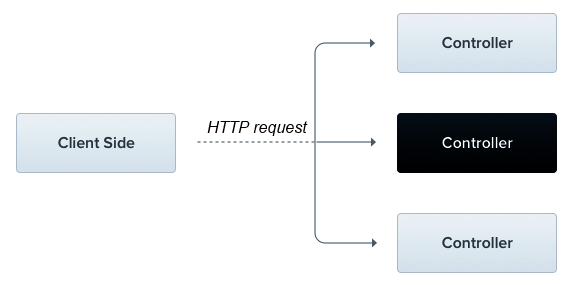One thing that NestJS has that Angular does not is controllers. Controllers are used to define endpoints in NestJS and to associate requests/parameters to functions/arguments, shown as follows:

NestJS's routing mechanism is responsible for identifying which controller should receive and process incoming requests. Indeed, NestJS's routing system is built upon Express or, optionally, Fastify (https://www.fastify.io).
A controller's purpose is to handle the requests targeting specific routes of the application. The routing mechanism controls which controllers/methods receive which requests.
Usually, controllers are associated with multiple routes, each of which implements different operations. For instance, in a Customer controller, we could define routes to handle the different CRUD operations.
NestJS controllers are created using TypeScript classes and dedicated decorators such as @Get(), @Post(), and @Body. These decorators associate the classes/methods with the metadata allowing NestJS to define its internal routing table.
Let's take a look at an example created using the CLI:
npx @nestjs/cli generate controller hello
Here is an example controller:
import {Controller, Get, Query} from '@nestjs/common';
@Controller('/')
export class HelloController {
@Get('hello')
hello(@Query('name') name?: string) {
const personName = name? name: 'stranger';
return `Hello ${personName}`;
}
}
Unsurprisingly, controllers are declared using the @Controller decorator. Within that decorator, we can set an optional base path associated with this controller. Here, we have set it to /to match the root route of the backend, but it isn't mandatory in this case.
The @Get('hello') decorator associates our hello method with the /hello route, which means our method will be invoked whenever a GET request is sent toward /hello. The method name actually doesn't matter. All that matters is the combination of the base path defined on the @Controller and/or the one defined on the method's decorator.
Also notice the @Query decorator, which we have used to retrieve the value of a query parameter (if present). In the method, we use the associated value (or lack thereof) to determine what message to return.
Accessing the URL http://localhost:3000/hello results in the following response: Hello stranger. If you provide the query parameter in the URL http://localhost:3000/hello?name=world, then the response becomes Hello world. Neat!
Of course, you can also access other parts of the request objects:
- Their body using @Body
- Path parameters using @Param
- Headers using @Headers
- Or even the whole request using @Request
Check out the official controller documentation to learn about how NestJS handles routing, method parameters, and return values.